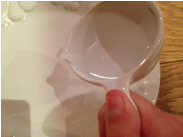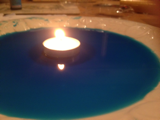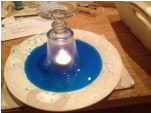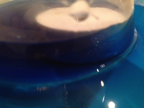What you need:
- 1 Candle
- Match/lighter
- Water
- 1 Glass
Step 1: Pour a small amount of water onto a shallow plate.
Step 2: Place your candle in the middle of the water. (Make sure the candle in the middle of the water doesn't touch the wick.
Step 3: Put a glass over the candle.
Step 2: Place your candle in the middle of the water. (Make sure the candle in the middle of the water doesn't touch the wick.
Step 3: Put a glass over the candle.
How does this happen?
The flame inside the glass uses oxygen to burn. This heats the air expanding the air. When all the oxygen is used, the flame goes out. The air starts to cool. The air cooling reduces the amount of air inside the jar. Now there is an empty space from no oxygen and the shrinking of the air which is the "vacuum". Now we have a situation where the air outside the jar has a higher pressure than inside and the "vacuum" that needs to be filled (though there are gases in the jar it's not oxygen - carbon dioxide, nitrogen, argon and others) so the higher force of pressure outside pushes the water into the jar from the plate!
The flame inside the glass uses oxygen to burn. This heats the air expanding the air. When all the oxygen is used, the flame goes out. The air starts to cool. The air cooling reduces the amount of air inside the jar. Now there is an empty space from no oxygen and the shrinking of the air which is the "vacuum". Now we have a situation where the air outside the jar has a higher pressure than inside and the "vacuum" that needs to be filled (though there are gases in the jar it's not oxygen - carbon dioxide, nitrogen, argon and others) so the higher force of pressure outside pushes the water into the jar from the plate!




